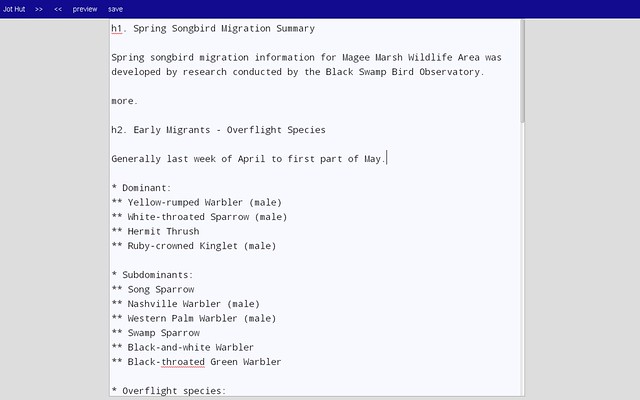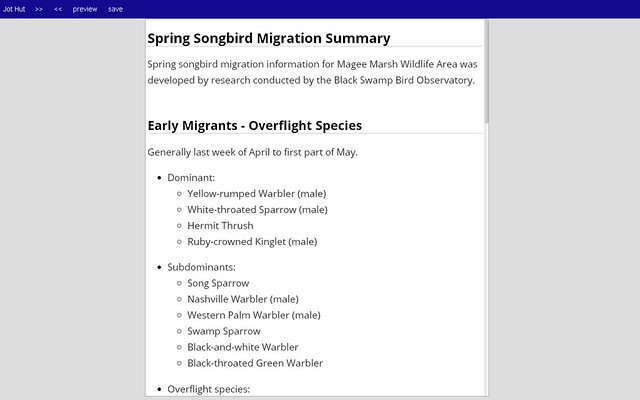You're viewing old version number 14. - Current version
Junco User Documentation
http://jothut.com/cgi-bin/junco.pl/blogpost/5499/17Oct2013/In-Progress-Junco-enduser-testing
Junco was designed to support multiple users who can follow users and tags and add replies.
But in the example usage below, the app is used as a one-person personal publishing site.
Example usage: http://jothut.com
Account Creation
A new user enters a username and a valid e-mail address. The system sends the user an e-mail with an auto-generated password and a link to activate the account. After the account is activated, the user can login.
Changing Password and E-mail
After logging in, the user can click on his or her username and follow the link and form fields to change the password and e-mail.
Editing the Profile Page
Users can personalize their profile page by adding links, plain text, or Textile markup to create HTML. The profile page data entry box supports template includes and the double-bracket wiki link feature.
Hashtags
Microblog posts (notes) and blog posts (articles) are limited to a max of eight hashtags.
Hashtag format consists of meaningful category text preceded by the pound sign.
Hashtags can be used to organize content.
I like to start with the general and move to the specific when including tags.
Examples (with the pound signs excluded):
- nature - insects - butterflies
- sports - football - nfl - browns
- media - design - mobile - app
Microblog Posts or Notes
These are short posts with a limit of 300 characters. They are entered in the small textarea box, located on the homepage.
Titles are not entered.
No preview, just a post button.
The only formatting includes:
- Raw URLs are converted into clickable links.
- Hashtags converted into clickable search links.
/1234/means linking to another microblog post that has ID number 1234.
These posts cannot be edited.
But microblog posts can be deleted from the home page stream by clicking the [delete] link. The post is not removed from the stream. A deleted post can only be viewed on the home page stream by the logged-in owner. The deleted post will appear with very small text with a light yellow background. The deleted post can be added to public viewing by clicking the [undelete] link.
The RSS stream for a user's microblog posts can be accessed on the user's profile page.
Blog Posts or Articles
These can be short or very long.
Posts can be entered in a medium-sized textarea box, or the enhanced 'editor' can be used.
Blog posts can be previewed before being saved.
Blog posts can be edited.
Old versions are preserved. To revert back to an old version, the user edits the old post and saves the post.
Differences can be run on two versions, showing changed, additions, and deletions.
No separate input text field exists for the title. The first line in the blog post is used as the title. If the line is long, then the first 150 characters will be the title.
If the title contains a colon punctuation mark, then the text preceding the punctuation mark must equal the username of the user creating the post. This namespace convention allows users to create common titles with their username in the title.
If a blog post is created with a title that matches an existing post that was created by any user, then an error will be displayed.
Blog posts support Textile, Markdown, and MultiMarkdown formatting. Textile is the default markup.
Many HTML tags are also supported.
Blog posts can be set to private where only the logged-in owner can view the post. It will not appear within the logged-in owner's home page stream. The owner can access private posts through the user's profile page.
If header lines are used within a blog post, then by default a table of contents is created and displayed at the upper right area of the page. The table of contents display, however, can be disabled.
Users can view the markup source for a blog post.
Enhanced Blog Writing Area
Can type and view in split-screen or single-screen modes.
Auto-save occurs every five minutes, provided that at least one key was pressed. The "save" link can be clicked to save too.
If the "preview" link is clicked while in split-screen mode, then the preview will be displayed in split-screen mode.
If the "preview" link is clicked while typing in single-screen mode, then the preview will be displayed in single-screen mode. This preview will display at the same width as the website's width defined in the CSS file.
Click the right arrows changes the mode to single-screen. Clicking the left arrows switches to split-screen mode.
This does not contain live preview. I find live preview too distracting. I could see letters flashing onto the preview part of the screen out of the corner of my eye as I typed. Plus, I have added too many custom formatting options, such as custom Textile-like formatting commands, template includes, etc., that are best achieved with a round-trip to the server. Since this round-trip is plenty fast, I don't see this as a problem.
Old screen shots.
split screen, typing on left and preview on right.

single screen view for typing.

single screen view for previewing.

Microblog posts which are created by typing in the small window on the home page cannot be edited.
Blog posts (long form posts) can be edited.
If you need to edit a blog post, click the "EDIT" link at the top or bottom of the page when viewing the post.
To edit with the "enhanced" view, then click the small "split" link, which is located near the lower right hand corner of the text area box.
Clicking the split link puts you into a better editing/writing area. This enhanced writing area auto-saves every 5 minutes if new content has been added (at least one key has been pressed.)
Within the enhanced writing area, you can either write and preview in split screen mode or you can click the right-facing arrows in the navigation bar to switch to single screen mode. This provides a larger writing screen.
When writing in single screen mode, when you click "preview," the formatted page will also be shown in single screen mode.
To change from previewing in single screen mode back to writing in single screen mode, click the right-facing arrows again.
To get back to split screen mode, click the left-facing arrows.
Click the arrows to play around. Nothing can be harmed.
To save when you want, obviously, click "save."
ONE FLAW that I have not fixed yet in the enhanced writing area: when my editing consists of nothing but cutting and pasting, the save and auto-save do not work because no keys were pressed to add content. [ #resolved on 23oct2013 ]
So to ensure all changes will be saved, hit the space bar once, (and if you want, you can delete the space) and then click "save."
When moving away from the enhanced writing area, you will get a pop-up message, asking if you want to leave the page. Click "confirm" or whatever the answer is to leave the page.
This confirmation pop-up will appear even after you have saved the content.
This confirmation exists because over the years, I've experienced times where I accidentally moved away from a page that I was adding content to, and when I quickly moved back, all my content was gone and not saved. So I added this pop-up to my new app as a safety feature.
This "confirm" pop-up does not function on Apple devices. I need to change/correct the JavaScript to enable the confirmation pop-up to work on iOS. [23Oct2012 update: "Looks like Apple has disabled the window.onbeforeunload event for iOS devices (iPhone, iPad, iPod Touch)." - Nov 2010 Stackoverflow post ]
From JR's : articles
1282 words - 7642 chars
- 7 min read
created on
updated on
- #
source
- versions